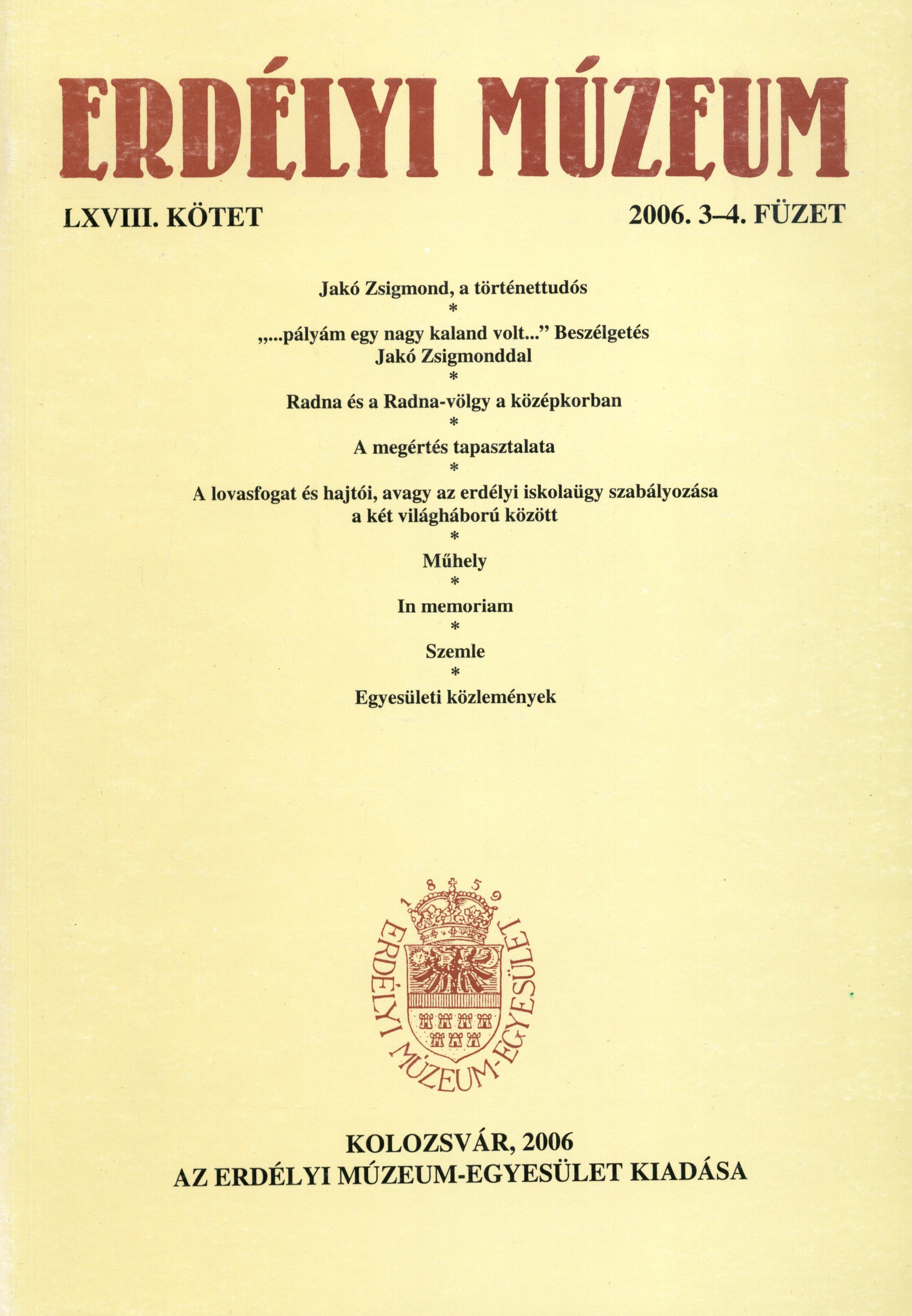Radna és a Radna-völgy a középkorban (1241–1469/1475). Birtok- és településtörténet
Rodna and the Rodna Valley in the Middle Ages (1241–1469/1475). A history of possession and settlement
Author(s): Géza HegyiSubject(s): Economic history, Ethnohistory, Political history, Social history, 13th to 14th Centuries, 15th Century
Published by: Erdélyi Múzeum-Egyesület
Keywords: Rodna valley; Rodna; Middle Ages; settlement-history;
Summary/Abstract: This study tries to present the history of a highland region of Transsylvania, its political-administrative and ethno-demographical evolution till its unification with the Saxon autonomous district. Primarily there have been arias with different juridical status in this region. The first-mentioned (and for a century, the most important one) of them was Radna/Rodna, a mining town with thousands of German (maybe Bavarian) inhabitants and their own autonomous institutions (magistrate, priest, inn, prison, market place, mills, gold and silver mines, etc.), working out a local law-book (cca 1270). The town (together with the Saxon district from Beszterce/Bistriţa) was the possession of Hungarian queens, that’s why it was exempted from the authority of shires (comitatus – megye) and organized as a county (comitatus – ispánság), ruled by an earl (comes) appointed by the royal family. They should not be mistaken for the members of the Radnai family, similary wearing the title comes: these were in fact the local leaders of the German community, named gräve~gereb (which ones could be found in many Saxon settlements from Transsylvania). At the same time, the Radnais weren’t the landowners of the town (there were living freeholders submitted only to the king and queen), unless they acquired more than seven surrounding nonprivilaged serf-villages (between 1239 and 1291). Appart from Radna, the settlements from Radna Valley (being serf-villages, too) lay on the territory of Inner Szolnok- shire. In 1334 we can find here only eight villages (Mákod/Mocod, Naszód/Năsăud, Telcs/Telciu, Nyírmező/ Feldra, Szentgyörgy/Sângeorz-Băi, Cybles, Korowgh, Hydmezeu, the last there have dissapeared till 1440). Their names suggest us the presence of a very sparse Slavic and Hungarian population. We can find out too, that the landowners of this estate was the up-mentioned Radnai family, but in the middle of the 14th century they lost all their domains (forced by other nobles or by economical needs) and the family has disappeared. The Radna Valley in cca 1378 (after the extinction of its last owners, the Pogány family) fell to the king and have been joined with the royal domain of Radna. This domain was governed (as a service-estate, called honor) by the Szekler earls, their castellanes and officiales. It seems to me, that because of the despotic local governement of one of the castellanes, Prokop (cca 1400), most of the settlements from the valley became depopulated, and the repeated attempts of the later Szekler earls to bring colonists here, failed. In 1440 both Radna with the royal castle and the villages from valley (now, beside of those from 1334, there are four new settlements: Zágra/Zagra, Szálva/Salva, Rebra, Kisrebra/Rebrişoara) are “in maiori parte ... vacuas et inhabitatoribus destitutas”. Probably the decline of the town is caused by the exhaustion of mines – an economical problem, which couldn’t be balanced by the presence of the tax office, placed at the commercial route to Poland and Moldavia. In 1440 the domain was donated by queen Elisabeth to the Jakcs de Kusaly family, with the aim of insuring their aid in the starting civil war (this purpose failed because of the former conflicts of the family with the royal power). The short period of landowning of the Jakcss (till 1451?) is important because of the topographical and demographial informations given by a charter from 1450, relating the division of the estate among the members of the family. According to this, on the domain there were 144 houses (sessio), which means cca 900 souls. Their names shows, that most of these serfs were Rumanian ethnics – we shall meet their leeders (kenez, woyuoda) in the second part of the century. It seems, that the Jakcss succeeded to recolonize the region and to estabilish a new village (Major/Maieru), too. However, the colonization has been continued in the following decades too (in 1495 there are already 444 houses and in 1523 appeared a new village: Hordó/Coşbuc). The Jakcs family lost this domain in the 1450’s because of their conflict with the governor John Hunyadi. That’s why in 1467 it is mentioned as a royal estate again. Not for a long time, because in 1469 king Mathias Hunyadi – trying to unite the anti-Turkish defence-sistem from Transsylvania – gave it to the Saxons from Beszterce/Bistriţa district. However, the new status of the territory has been unclear for most of the contemporary people (mainly for collectors of taxes): they considered that it had changed only the landowner, but the region remained part of the shires and the noble-right, while the Saxon people said, that it had become part of their autunomous district and that’s why it is duty-free. In his renewed donation (1475), king Mathias accepted the Saxon point of view and offered to Radna the Saxon privileges.
Journal: Erdélyi Múzeum
- Issue Year: LXVIII/2006
- Issue No: 3-4
- Page Range: 33-54
- Page Count: 22
- Language: Hungarian

